Report: Analysis of Curriculum Design and Development in Education
VerifiedAdded on 2023/06/08
|20
|5824
|126
Report
AI Summary
This report delves into the multifaceted aspects of curriculum design and development, with a specific focus on English grammar education. It begins by analyzing the core purposes of curriculum design, including academic, social, economic, and political dimensions. The report then evaluates various approaches and models, such as subject-centered, learner-centered, and problem-centered approaches, alongside models like Tyler's Product Model and Stenhouse's Process Model. A significant portion is dedicated to the importance of learner feedback in shaping the curriculum, ensuring inclusivity, and aligning with organizational policies. Risk management strategies, including the Curriculum Activity Risk Assessment (CARA) process, are explored, along with methodologies for monitoring and evaluating curriculum effectiveness. The report further outlines the identification of learning objectives, the creation of a curriculum for an education and training program, and the planning of appropriate assessment approaches. Finally, the report evaluates the achievement of learning outcomes, the delivery of the curriculum, and identifies areas for improvement, concluding with suggestions for enhancements.

Curriculum Design
Paraphrase This Document
Need a fresh take? Get an instant paraphrase of this document with our AI Paraphraser
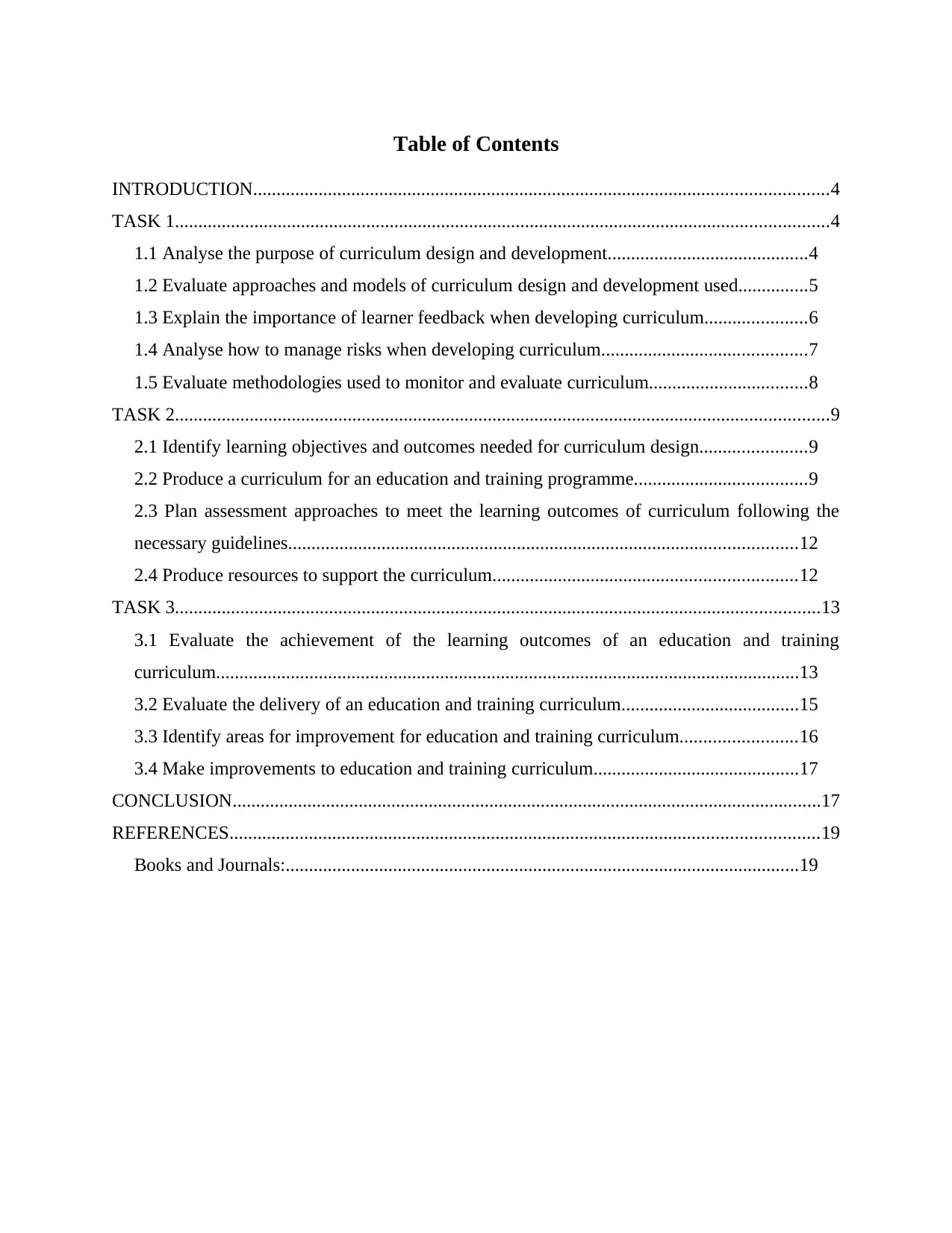
Table of Contents
INTRODUCTION...........................................................................................................................4
TASK 1............................................................................................................................................4
1.1 Analyse the purpose of curriculum design and development...........................................4
1.2 Evaluate approaches and models of curriculum design and development used...............5
1.3 Explain the importance of learner feedback when developing curriculum......................6
1.4 Analyse how to manage risks when developing curriculum............................................7
1.5 Evaluate methodologies used to monitor and evaluate curriculum..................................8
TASK 2............................................................................................................................................9
2.1 Identify learning objectives and outcomes needed for curriculum design.......................9
2.2 Produce a curriculum for an education and training programme.....................................9
2.3 Plan assessment approaches to meet the learning outcomes of curriculum following the
necessary guidelines.............................................................................................................12
2.4 Produce resources to support the curriculum.................................................................12
TASK 3..........................................................................................................................................13
3.1 Evaluate the achievement of the learning outcomes of an education and training
curriculum.............................................................................................................................13
3.2 Evaluate the delivery of an education and training curriculum......................................15
3.3 Identify areas for improvement for education and training curriculum.........................16
3.4 Make improvements to education and training curriculum............................................17
CONCLUSION..............................................................................................................................17
REFERENCES..............................................................................................................................19
Books and Journals:..............................................................................................................19
INTRODUCTION...........................................................................................................................4
TASK 1............................................................................................................................................4
1.1 Analyse the purpose of curriculum design and development...........................................4
1.2 Evaluate approaches and models of curriculum design and development used...............5
1.3 Explain the importance of learner feedback when developing curriculum......................6
1.4 Analyse how to manage risks when developing curriculum............................................7
1.5 Evaluate methodologies used to monitor and evaluate curriculum..................................8
TASK 2............................................................................................................................................9
2.1 Identify learning objectives and outcomes needed for curriculum design.......................9
2.2 Produce a curriculum for an education and training programme.....................................9
2.3 Plan assessment approaches to meet the learning outcomes of curriculum following the
necessary guidelines.............................................................................................................12
2.4 Produce resources to support the curriculum.................................................................12
TASK 3..........................................................................................................................................13
3.1 Evaluate the achievement of the learning outcomes of an education and training
curriculum.............................................................................................................................13
3.2 Evaluate the delivery of an education and training curriculum......................................15
3.3 Identify areas for improvement for education and training curriculum.........................16
3.4 Make improvements to education and training curriculum............................................17
CONCLUSION..............................................................................................................................17
REFERENCES..............................................................................................................................19
Books and Journals:..............................................................................................................19

⊘ This is a preview!⊘
Do you want full access?
Subscribe today to unlock all pages.

Trusted by 1+ million students worldwide
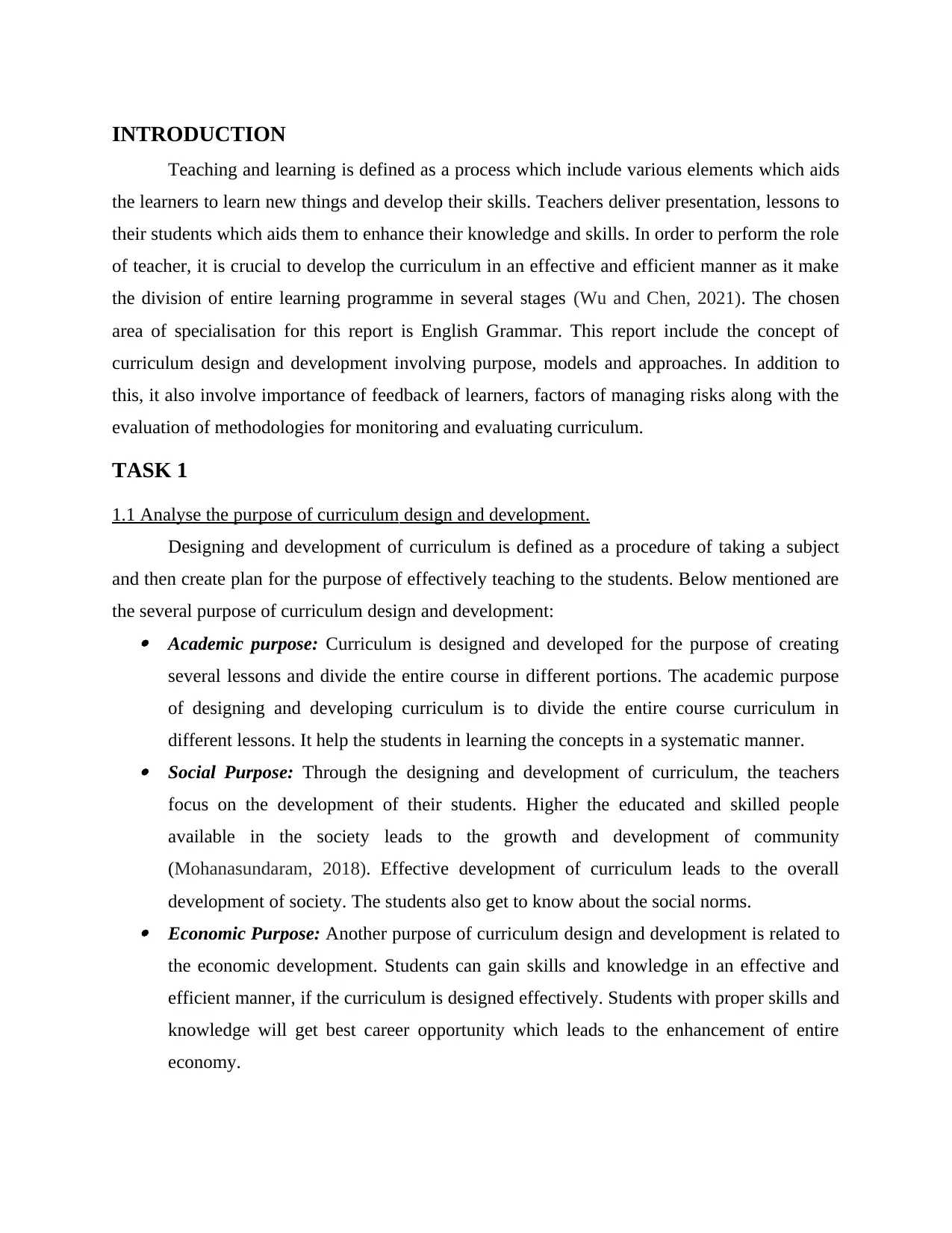
INTRODUCTION
Teaching and learning is defined as a process which include various elements which aids
the learners to learn new things and develop their skills. Teachers deliver presentation, lessons to
their students which aids them to enhance their knowledge and skills. In order to perform the role
of teacher, it is crucial to develop the curriculum in an effective and efficient manner as it make
the division of entire learning programme in several stages (Wu and Chen, 2021). The chosen
area of specialisation for this report is English Grammar. This report include the concept of
curriculum design and development involving purpose, models and approaches. In addition to
this, it also involve importance of feedback of learners, factors of managing risks along with the
evaluation of methodologies for monitoring and evaluating curriculum.
TASK 1
1.1 Analyse the purpose of curriculum design and development.
Designing and development of curriculum is defined as a procedure of taking a subject
and then create plan for the purpose of effectively teaching to the students. Below mentioned are
the several purpose of curriculum design and development: Academic purpose: Curriculum is designed and developed for the purpose of creating
several lessons and divide the entire course in different portions. The academic purpose
of designing and developing curriculum is to divide the entire course curriculum in
different lessons. It help the students in learning the concepts in a systematic manner. Social Purpose: Through the designing and development of curriculum, the teachers
focus on the development of their students. Higher the educated and skilled people
available in the society leads to the growth and development of community
(Mohanasundaram, 2018). Effective development of curriculum leads to the overall
development of society. The students also get to know about the social norms. Economic Purpose: Another purpose of curriculum design and development is related to
the economic development. Students can gain skills and knowledge in an effective and
efficient manner, if the curriculum is designed effectively. Students with proper skills and
knowledge will get best career opportunity which leads to the enhancement of entire
economy.
Teaching and learning is defined as a process which include various elements which aids
the learners to learn new things and develop their skills. Teachers deliver presentation, lessons to
their students which aids them to enhance their knowledge and skills. In order to perform the role
of teacher, it is crucial to develop the curriculum in an effective and efficient manner as it make
the division of entire learning programme in several stages (Wu and Chen, 2021). The chosen
area of specialisation for this report is English Grammar. This report include the concept of
curriculum design and development involving purpose, models and approaches. In addition to
this, it also involve importance of feedback of learners, factors of managing risks along with the
evaluation of methodologies for monitoring and evaluating curriculum.
TASK 1
1.1 Analyse the purpose of curriculum design and development.
Designing and development of curriculum is defined as a procedure of taking a subject
and then create plan for the purpose of effectively teaching to the students. Below mentioned are
the several purpose of curriculum design and development: Academic purpose: Curriculum is designed and developed for the purpose of creating
several lessons and divide the entire course in different portions. The academic purpose
of designing and developing curriculum is to divide the entire course curriculum in
different lessons. It help the students in learning the concepts in a systematic manner. Social Purpose: Through the designing and development of curriculum, the teachers
focus on the development of their students. Higher the educated and skilled people
available in the society leads to the growth and development of community
(Mohanasundaram, 2018). Effective development of curriculum leads to the overall
development of society. The students also get to know about the social norms. Economic Purpose: Another purpose of curriculum design and development is related to
the economic development. Students can gain skills and knowledge in an effective and
efficient manner, if the curriculum is designed effectively. Students with proper skills and
knowledge will get best career opportunity which leads to the enhancement of entire
economy.
Paraphrase This Document
Need a fresh take? Get an instant paraphrase of this document with our AI Paraphraser
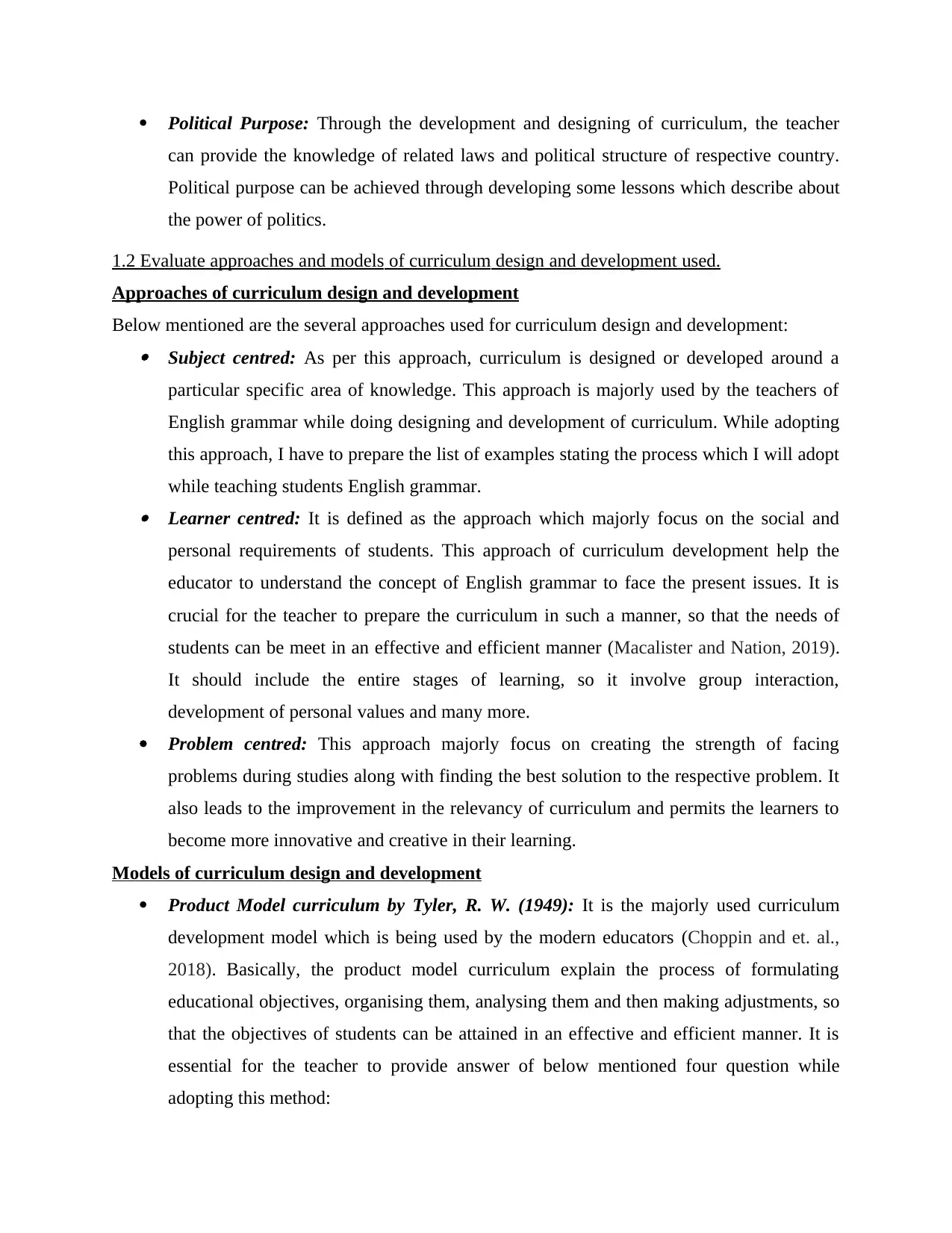
Political Purpose: Through the development and designing of curriculum, the teacher
can provide the knowledge of related laws and political structure of respective country.
Political purpose can be achieved through developing some lessons which describe about
the power of politics.
1.2 Evaluate approaches and models of curriculum design and development used.
Approaches of curriculum design and development
Below mentioned are the several approaches used for curriculum design and development: Subject centred: As per this approach, curriculum is designed or developed around a
particular specific area of knowledge. This approach is majorly used by the teachers of
English grammar while doing designing and development of curriculum. While adopting
this approach, I have to prepare the list of examples stating the process which I will adopt
while teaching students English grammar. Learner centred: It is defined as the approach which majorly focus on the social and
personal requirements of students. This approach of curriculum development help the
educator to understand the concept of English grammar to face the present issues. It is
crucial for the teacher to prepare the curriculum in such a manner, so that the needs of
students can be meet in an effective and efficient manner (Macalister and Nation, 2019).
It should include the entire stages of learning, so it involve group interaction,
development of personal values and many more.
Problem centred: This approach majorly focus on creating the strength of facing
problems during studies along with finding the best solution to the respective problem. It
also leads to the improvement in the relevancy of curriculum and permits the learners to
become more innovative and creative in their learning.
Models of curriculum design and development
Product Model curriculum by Tyler, R. W. (1949): It is the majorly used curriculum
development model which is being used by the modern educators (Choppin and et. al.,
2018). Basically, the product model curriculum explain the process of formulating
educational objectives, organising them, analysing them and then making adjustments, so
that the objectives of students can be attained in an effective and efficient manner. It is
essential for the teacher to provide answer of below mentioned four question while
adopting this method:
can provide the knowledge of related laws and political structure of respective country.
Political purpose can be achieved through developing some lessons which describe about
the power of politics.
1.2 Evaluate approaches and models of curriculum design and development used.
Approaches of curriculum design and development
Below mentioned are the several approaches used for curriculum design and development: Subject centred: As per this approach, curriculum is designed or developed around a
particular specific area of knowledge. This approach is majorly used by the teachers of
English grammar while doing designing and development of curriculum. While adopting
this approach, I have to prepare the list of examples stating the process which I will adopt
while teaching students English grammar. Learner centred: It is defined as the approach which majorly focus on the social and
personal requirements of students. This approach of curriculum development help the
educator to understand the concept of English grammar to face the present issues. It is
crucial for the teacher to prepare the curriculum in such a manner, so that the needs of
students can be meet in an effective and efficient manner (Macalister and Nation, 2019).
It should include the entire stages of learning, so it involve group interaction,
development of personal values and many more.
Problem centred: This approach majorly focus on creating the strength of facing
problems during studies along with finding the best solution to the respective problem. It
also leads to the improvement in the relevancy of curriculum and permits the learners to
become more innovative and creative in their learning.
Models of curriculum design and development
Product Model curriculum by Tyler, R. W. (1949): It is the majorly used curriculum
development model which is being used by the modern educators (Choppin and et. al.,
2018). Basically, the product model curriculum explain the process of formulating
educational objectives, organising them, analysing them and then making adjustments, so
that the objectives of students can be attained in an effective and efficient manner. It is
essential for the teacher to provide answer of below mentioned four question while
adopting this method:
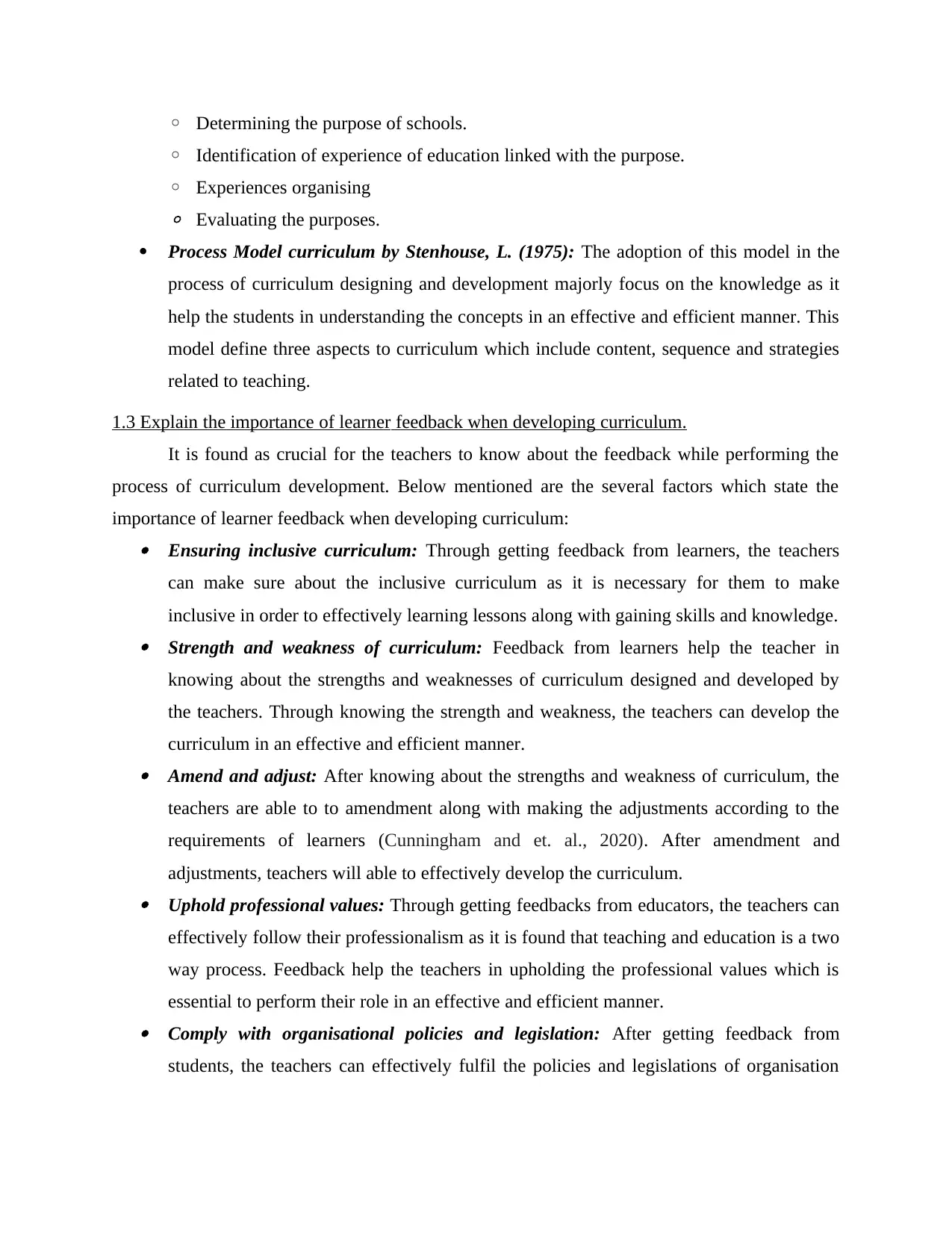
◦ Determining the purpose of schools.
◦ Identification of experience of education linked with the purpose.
◦ Experiences organising
◦ Evaluating the purposes.
Process Model curriculum by Stenhouse, L. (1975): The adoption of this model in the
process of curriculum designing and development majorly focus on the knowledge as it
help the students in understanding the concepts in an effective and efficient manner. This
model define three aspects to curriculum which include content, sequence and strategies
related to teaching.
1.3 Explain the importance of learner feedback when developing curriculum.
It is found as crucial for the teachers to know about the feedback while performing the
process of curriculum development. Below mentioned are the several factors which state the
importance of learner feedback when developing curriculum: Ensuring inclusive curriculum: Through getting feedback from learners, the teachers
can make sure about the inclusive curriculum as it is necessary for them to make
inclusive in order to effectively learning lessons along with gaining skills and knowledge. Strength and weakness of curriculum: Feedback from learners help the teacher in
knowing about the strengths and weaknesses of curriculum designed and developed by
the teachers. Through knowing the strength and weakness, the teachers can develop the
curriculum in an effective and efficient manner. Amend and adjust: After knowing about the strengths and weakness of curriculum, the
teachers are able to to amendment along with making the adjustments according to the
requirements of learners (Cunningham and et. al., 2020). After amendment and
adjustments, teachers will able to effectively develop the curriculum. Uphold professional values: Through getting feedbacks from educators, the teachers can
effectively follow their professionalism as it is found that teaching and education is a two
way process. Feedback help the teachers in upholding the professional values which is
essential to perform their role in an effective and efficient manner. Comply with organisational policies and legislation: After getting feedback from
students, the teachers can effectively fulfil the policies and legislations of organisation
◦ Identification of experience of education linked with the purpose.
◦ Experiences organising
◦ Evaluating the purposes.
Process Model curriculum by Stenhouse, L. (1975): The adoption of this model in the
process of curriculum designing and development majorly focus on the knowledge as it
help the students in understanding the concepts in an effective and efficient manner. This
model define three aspects to curriculum which include content, sequence and strategies
related to teaching.
1.3 Explain the importance of learner feedback when developing curriculum.
It is found as crucial for the teachers to know about the feedback while performing the
process of curriculum development. Below mentioned are the several factors which state the
importance of learner feedback when developing curriculum: Ensuring inclusive curriculum: Through getting feedback from learners, the teachers
can make sure about the inclusive curriculum as it is necessary for them to make
inclusive in order to effectively learning lessons along with gaining skills and knowledge. Strength and weakness of curriculum: Feedback from learners help the teacher in
knowing about the strengths and weaknesses of curriculum designed and developed by
the teachers. Through knowing the strength and weakness, the teachers can develop the
curriculum in an effective and efficient manner. Amend and adjust: After knowing about the strengths and weakness of curriculum, the
teachers are able to to amendment along with making the adjustments according to the
requirements of learners (Cunningham and et. al., 2020). After amendment and
adjustments, teachers will able to effectively develop the curriculum. Uphold professional values: Through getting feedbacks from educators, the teachers can
effectively follow their professionalism as it is found that teaching and education is a two
way process. Feedback help the teachers in upholding the professional values which is
essential to perform their role in an effective and efficient manner. Comply with organisational policies and legislation: After getting feedback from
students, the teachers can effectively fulfil the policies and legislations of organisation
⊘ This is a preview!⊘
Do you want full access?
Subscribe today to unlock all pages.

Trusted by 1+ million students worldwide
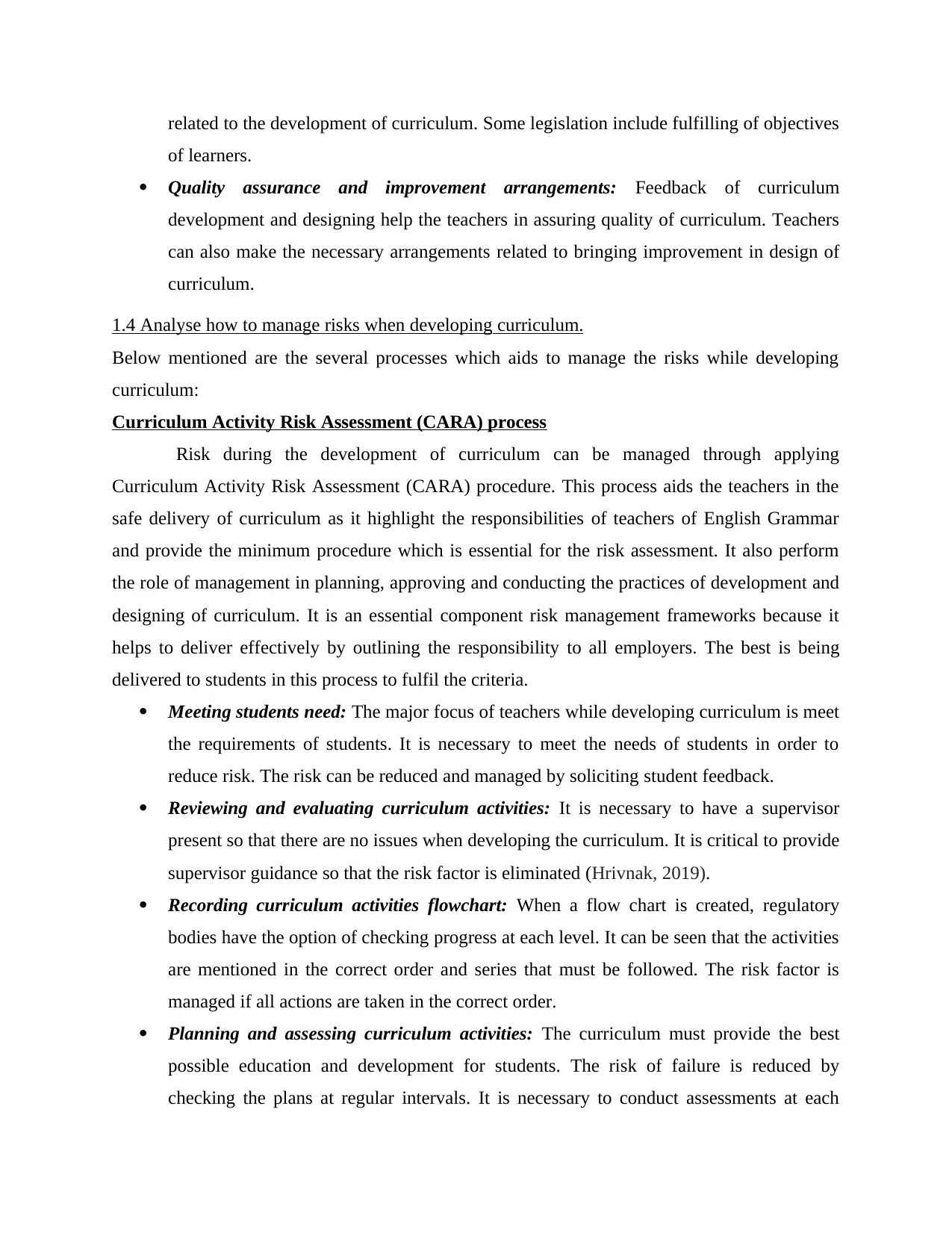
related to the development of curriculum. Some legislation include fulfilling of objectives
of learners.
Quality assurance and improvement arrangements: Feedback of curriculum
development and designing help the teachers in assuring quality of curriculum. Teachers
can also make the necessary arrangements related to bringing improvement in design of
curriculum.
1.4 Analyse how to manage risks when developing curriculum.
Below mentioned are the several processes which aids to manage the risks while developing
curriculum:
Curriculum Activity Risk Assessment (CARA) process
Risk during the development of curriculum can be managed through applying
Curriculum Activity Risk Assessment (CARA) procedure. This process aids the teachers in the
safe delivery of curriculum as it highlight the responsibilities of teachers of English Grammar
and provide the minimum procedure which is essential for the risk assessment. It also perform
the role of management in planning, approving and conducting the practices of development and
designing of curriculum. It is an essential component risk management frameworks because it
helps to deliver effectively by outlining the responsibility to all employers. The best is being
delivered to students in this process to fulfil the criteria.
Meeting students need: The major focus of teachers while developing curriculum is meet
the requirements of students. It is necessary to meet the needs of students in order to
reduce risk. The risk can be reduced and managed by soliciting student feedback.
Reviewing and evaluating curriculum activities: It is necessary to have a supervisor
present so that there are no issues when developing the curriculum. It is critical to provide
supervisor guidance so that the risk factor is eliminated (Hrivnak, 2019).
Recording curriculum activities flowchart: When a flow chart is created, regulatory
bodies have the option of checking progress at each level. It can be seen that the activities
are mentioned in the correct order and series that must be followed. The risk factor is
managed if all actions are taken in the correct order.
Planning and assessing curriculum activities: The curriculum must provide the best
possible education and development for students. The risk of failure is reduced by
checking the plans at regular intervals. It is necessary to conduct assessments at each
of learners.
Quality assurance and improvement arrangements: Feedback of curriculum
development and designing help the teachers in assuring quality of curriculum. Teachers
can also make the necessary arrangements related to bringing improvement in design of
curriculum.
1.4 Analyse how to manage risks when developing curriculum.
Below mentioned are the several processes which aids to manage the risks while developing
curriculum:
Curriculum Activity Risk Assessment (CARA) process
Risk during the development of curriculum can be managed through applying
Curriculum Activity Risk Assessment (CARA) procedure. This process aids the teachers in the
safe delivery of curriculum as it highlight the responsibilities of teachers of English Grammar
and provide the minimum procedure which is essential for the risk assessment. It also perform
the role of management in planning, approving and conducting the practices of development and
designing of curriculum. It is an essential component risk management frameworks because it
helps to deliver effectively by outlining the responsibility to all employers. The best is being
delivered to students in this process to fulfil the criteria.
Meeting students need: The major focus of teachers while developing curriculum is meet
the requirements of students. It is necessary to meet the needs of students in order to
reduce risk. The risk can be reduced and managed by soliciting student feedback.
Reviewing and evaluating curriculum activities: It is necessary to have a supervisor
present so that there are no issues when developing the curriculum. It is critical to provide
supervisor guidance so that the risk factor is eliminated (Hrivnak, 2019).
Recording curriculum activities flowchart: When a flow chart is created, regulatory
bodies have the option of checking progress at each level. It can be seen that the activities
are mentioned in the correct order and series that must be followed. The risk factor is
managed if all actions are taken in the correct order.
Planning and assessing curriculum activities: The curriculum must provide the best
possible education and development for students. The risk of failure is reduced by
checking the plans at regular intervals. It is necessary to conduct assessments at each
Paraphrase This Document
Need a fresh take? Get an instant paraphrase of this document with our AI Paraphraser
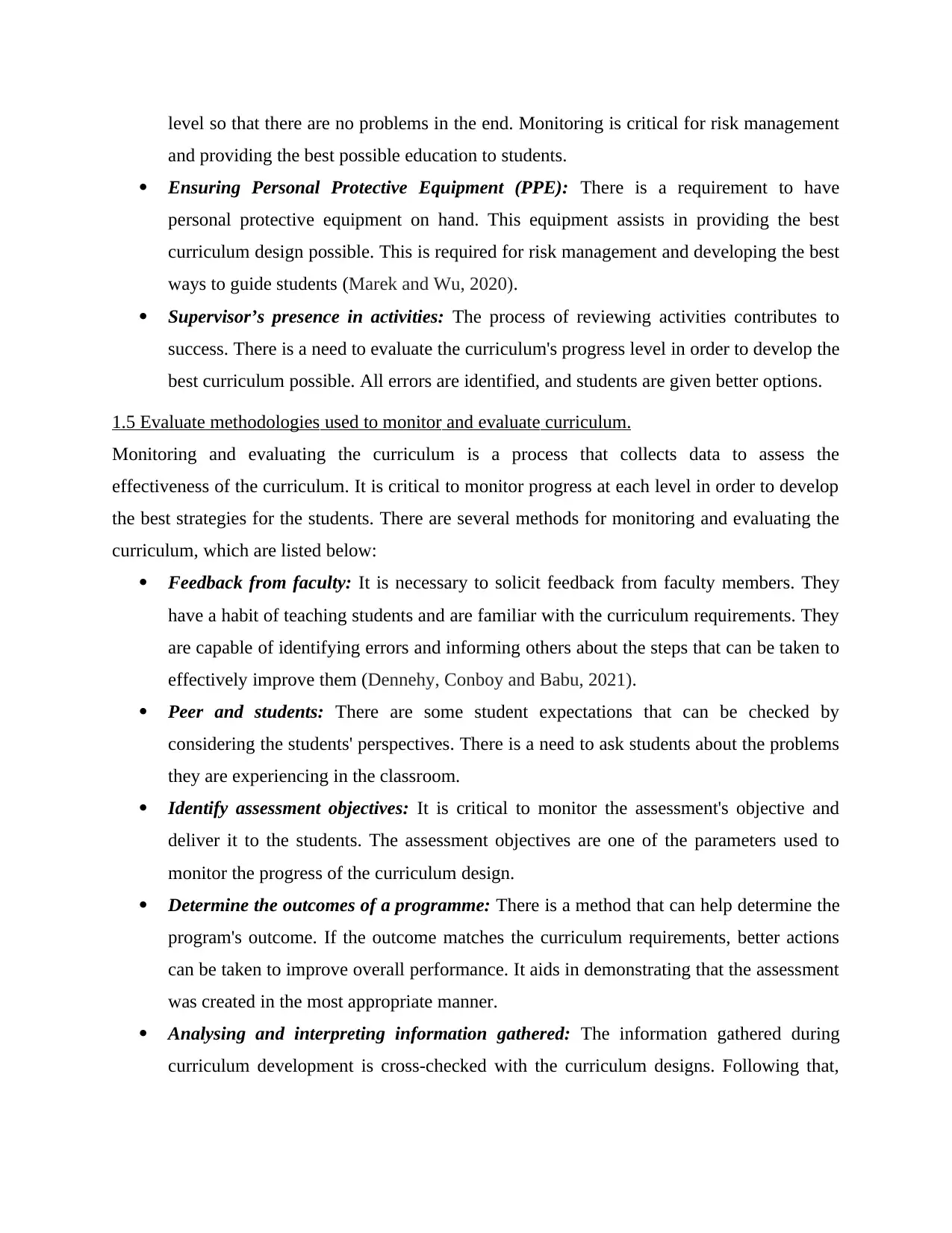
level so that there are no problems in the end. Monitoring is critical for risk management
and providing the best possible education to students.
Ensuring Personal Protective Equipment (PPE): There is a requirement to have
personal protective equipment on hand. This equipment assists in providing the best
curriculum design possible. This is required for risk management and developing the best
ways to guide students (Marek and Wu, 2020).
Supervisor’s presence in activities: The process of reviewing activities contributes to
success. There is a need to evaluate the curriculum's progress level in order to develop the
best curriculum possible. All errors are identified, and students are given better options.
1.5 Evaluate methodologies used to monitor and evaluate curriculum.
Monitoring and evaluating the curriculum is a process that collects data to assess the
effectiveness of the curriculum. It is critical to monitor progress at each level in order to develop
the best strategies for the students. There are several methods for monitoring and evaluating the
curriculum, which are listed below:
Feedback from faculty: It is necessary to solicit feedback from faculty members. They
have a habit of teaching students and are familiar with the curriculum requirements. They
are capable of identifying errors and informing others about the steps that can be taken to
effectively improve them (Dennehy, Conboy and Babu, 2021).
Peer and students: There are some student expectations that can be checked by
considering the students' perspectives. There is a need to ask students about the problems
they are experiencing in the classroom.
Identify assessment objectives: It is critical to monitor the assessment's objective and
deliver it to the students. The assessment objectives are one of the parameters used to
monitor the progress of the curriculum design.
Determine the outcomes of a programme: There is a method that can help determine the
program's outcome. If the outcome matches the curriculum requirements, better actions
can be taken to improve overall performance. It aids in demonstrating that the assessment
was created in the most appropriate manner.
Analysing and interpreting information gathered: The information gathered during
curriculum development is cross-checked with the curriculum designs. Following that,
and providing the best possible education to students.
Ensuring Personal Protective Equipment (PPE): There is a requirement to have
personal protective equipment on hand. This equipment assists in providing the best
curriculum design possible. This is required for risk management and developing the best
ways to guide students (Marek and Wu, 2020).
Supervisor’s presence in activities: The process of reviewing activities contributes to
success. There is a need to evaluate the curriculum's progress level in order to develop the
best curriculum possible. All errors are identified, and students are given better options.
1.5 Evaluate methodologies used to monitor and evaluate curriculum.
Monitoring and evaluating the curriculum is a process that collects data to assess the
effectiveness of the curriculum. It is critical to monitor progress at each level in order to develop
the best strategies for the students. There are several methods for monitoring and evaluating the
curriculum, which are listed below:
Feedback from faculty: It is necessary to solicit feedback from faculty members. They
have a habit of teaching students and are familiar with the curriculum requirements. They
are capable of identifying errors and informing others about the steps that can be taken to
effectively improve them (Dennehy, Conboy and Babu, 2021).
Peer and students: There are some student expectations that can be checked by
considering the students' perspectives. There is a need to ask students about the problems
they are experiencing in the classroom.
Identify assessment objectives: It is critical to monitor the assessment's objective and
deliver it to the students. The assessment objectives are one of the parameters used to
monitor the progress of the curriculum design.
Determine the outcomes of a programme: There is a method that can help determine the
program's outcome. If the outcome matches the curriculum requirements, better actions
can be taken to improve overall performance. It aids in demonstrating that the assessment
was created in the most appropriate manner.
Analysing and interpreting information gathered: The information gathered during
curriculum development is cross-checked with the curriculum designs. Following that,

the gaps are identified, and actions are taken to fill the gaps. It is necessary to effectively
interpret the information.
Improve methods of teaching and instructional techniques: Respect can be reduced by
using the best curriculum development techniques. It is clear that there are some methods
that aid in the improvement of teaching techniques and the development of a good
curriculum for students. This aids in evaluating the curriculum and achieving the best
results possible.
Assessment of curriculum outcomes: The assessment results also help to determine
whether or not the curriculum is designed properly (Pieters, Voogt and Pareja Roblin,
2019). For the overall success of the curriculum, information must be analysed and
worked on.
TASK 2
2.1 Identify learning objectives and outcomes needed for curriculum design.
2.2 Produce a curriculum for an education and training programme.
Developing Curriculum
(AC-2.1 and 2.2)
Programme/
Course:
Certificate in Education and Training (CET)
Level: 3/4
Duration: 16 weeks
Teaching
Hours:
70
Method of
Teaching:
Full time course
Virtual learning and face to face learning
Aim: Providing the knowledge of different roles and responsibilities in teaching
and learning.
interpret the information.
Improve methods of teaching and instructional techniques: Respect can be reduced by
using the best curriculum development techniques. It is clear that there are some methods
that aid in the improvement of teaching techniques and the development of a good
curriculum for students. This aids in evaluating the curriculum and achieving the best
results possible.
Assessment of curriculum outcomes: The assessment results also help to determine
whether or not the curriculum is designed properly (Pieters, Voogt and Pareja Roblin,
2019). For the overall success of the curriculum, information must be analysed and
worked on.
TASK 2
2.1 Identify learning objectives and outcomes needed for curriculum design.
2.2 Produce a curriculum for an education and training programme.
Developing Curriculum
(AC-2.1 and 2.2)
Programme/
Course:
Certificate in Education and Training (CET)
Level: 3/4
Duration: 16 weeks
Teaching
Hours:
70
Method of
Teaching:
Full time course
Virtual learning and face to face learning
Aim: Providing the knowledge of different roles and responsibilities in teaching
and learning.
⊘ This is a preview!⊘
Do you want full access?
Subscribe today to unlock all pages.

Trusted by 1+ million students worldwide
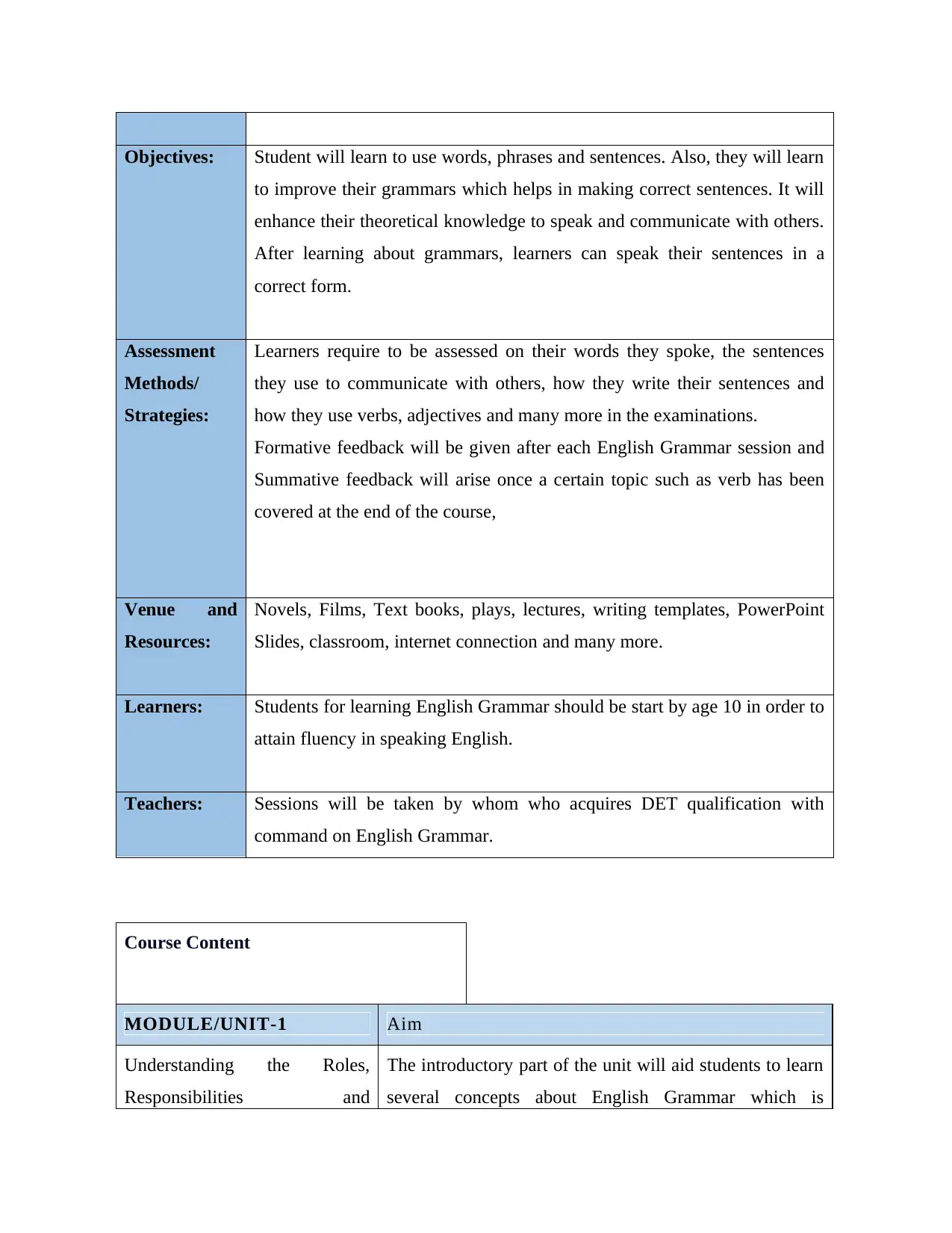
Objectives: Student will learn to use words, phrases and sentences. Also, they will learn
to improve their grammars which helps in making correct sentences. It will
enhance their theoretical knowledge to speak and communicate with others.
After learning about grammars, learners can speak their sentences in a
correct form.
Assessment
Methods/
Strategies:
Learners require to be assessed on their words they spoke, the sentences
they use to communicate with others, how they write their sentences and
how they use verbs, adjectives and many more in the examinations.
Formative feedback will be given after each English Grammar session and
Summative feedback will arise once a certain topic such as verb has been
covered at the end of the course,
Venue and
Resources:
Novels, Films, Text books, plays, lectures, writing templates, PowerPoint
Slides, classroom, internet connection and many more.
Learners: Students for learning English Grammar should be start by age 10 in order to
attain fluency in speaking English.
Teachers: Sessions will be taken by whom who acquires DET qualification with
command on English Grammar.
Course Content
MODULE/UNIT-1 Aim
Understanding the Roles,
Responsibilities and
The introductory part of the unit will aid students to learn
several concepts about English Grammar which is
to improve their grammars which helps in making correct sentences. It will
enhance their theoretical knowledge to speak and communicate with others.
After learning about grammars, learners can speak their sentences in a
correct form.
Assessment
Methods/
Strategies:
Learners require to be assessed on their words they spoke, the sentences
they use to communicate with others, how they write their sentences and
how they use verbs, adjectives and many more in the examinations.
Formative feedback will be given after each English Grammar session and
Summative feedback will arise once a certain topic such as verb has been
covered at the end of the course,
Venue and
Resources:
Novels, Films, Text books, plays, lectures, writing templates, PowerPoint
Slides, classroom, internet connection and many more.
Learners: Students for learning English Grammar should be start by age 10 in order to
attain fluency in speaking English.
Teachers: Sessions will be taken by whom who acquires DET qualification with
command on English Grammar.
Course Content
MODULE/UNIT-1 Aim
Understanding the Roles,
Responsibilities and
The introductory part of the unit will aid students to learn
several concepts about English Grammar which is
Paraphrase This Document
Need a fresh take? Get an instant paraphrase of this document with our AI Paraphraser
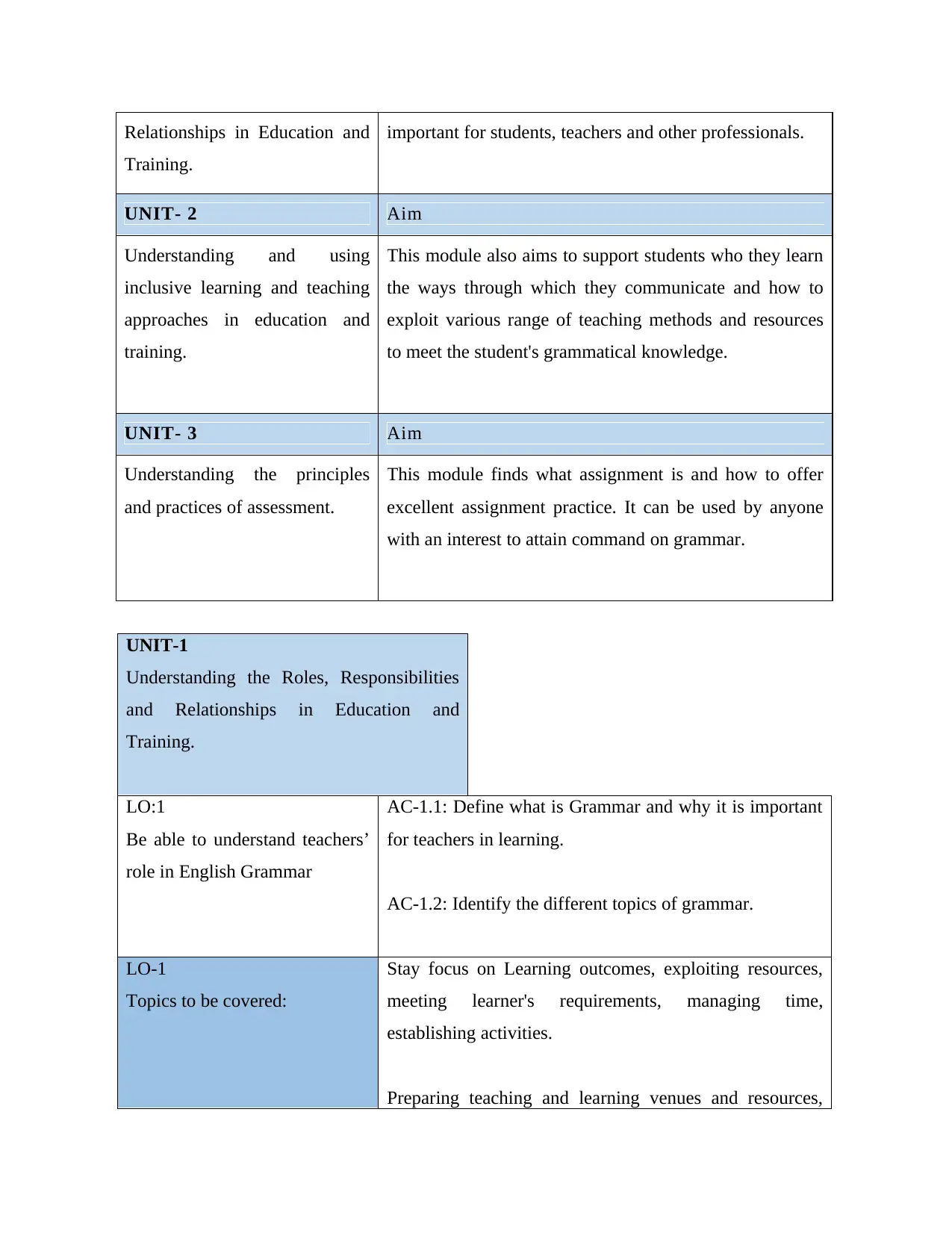
Relationships in Education and
Training.
important for students, teachers and other professionals.
UNIT- 2 Aim
Understanding and using
inclusive learning and teaching
approaches in education and
training.
This module also aims to support students who they learn
the ways through which they communicate and how to
exploit various range of teaching methods and resources
to meet the student's grammatical knowledge.
UNIT- 3 Aim
Understanding the principles
and practices of assessment.
This module finds what assignment is and how to offer
excellent assignment practice. It can be used by anyone
with an interest to attain command on grammar.
UNIT-1
Understanding the Roles, Responsibilities
and Relationships in Education and
Training.
LO:1
Be able to understand teachers’
role in English Grammar
AC-1.1: Define what is Grammar and why it is important
for teachers in learning.
AC-1.2: Identify the different topics of grammar.
LO-1
Topics to be covered:
Stay focus on Learning outcomes, exploiting resources,
meeting learner's requirements, managing time,
establishing activities.
Preparing teaching and learning venues and resources,
Training.
important for students, teachers and other professionals.
UNIT- 2 Aim
Understanding and using
inclusive learning and teaching
approaches in education and
training.
This module also aims to support students who they learn
the ways through which they communicate and how to
exploit various range of teaching methods and resources
to meet the student's grammatical knowledge.
UNIT- 3 Aim
Understanding the principles
and practices of assessment.
This module finds what assignment is and how to offer
excellent assignment practice. It can be used by anyone
with an interest to attain command on grammar.
UNIT-1
Understanding the Roles, Responsibilities
and Relationships in Education and
Training.
LO:1
Be able to understand teachers’
role in English Grammar
AC-1.1: Define what is Grammar and why it is important
for teachers in learning.
AC-1.2: Identify the different topics of grammar.
LO-1
Topics to be covered:
Stay focus on Learning outcomes, exploiting resources,
meeting learner's requirements, managing time,
establishing activities.
Preparing teaching and learning venues and resources,
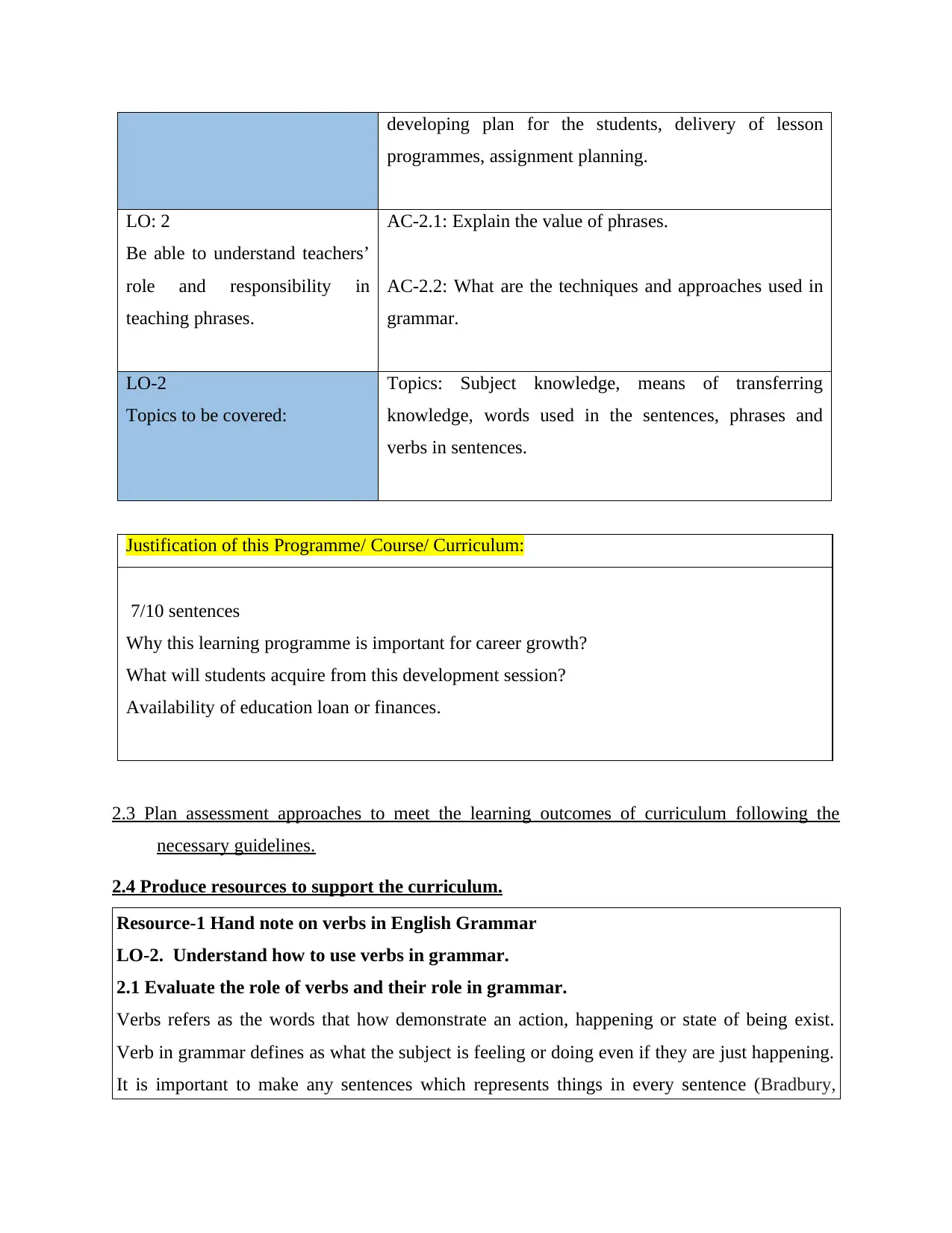
developing plan for the students, delivery of lesson
programmes, assignment planning.
LO: 2
Be able to understand teachers’
role and responsibility in
teaching phrases.
AC-2.1: Explain the value of phrases.
AC-2.2: What are the techniques and approaches used in
grammar.
LO-2
Topics to be covered:
Topics: Subject knowledge, means of transferring
knowledge, words used in the sentences, phrases and
verbs in sentences.
Justification of this Programme/ Course/ Curriculum:
7/10 sentences
Why this learning programme is important for career growth?
What will students acquire from this development session?
Availability of education loan or finances.
2.3 Plan assessment approaches to meet the learning outcomes of curriculum following the
necessary guidelines.
2.4 Produce resources to support the curriculum.
Resource-1 Hand note on verbs in English Grammar
LO-2. Understand how to use verbs in grammar.
2.1 Evaluate the role of verbs and their role in grammar.
Verbs refers as the words that how demonstrate an action, happening or state of being exist.
Verb in grammar defines as what the subject is feeling or doing even if they are just happening.
It is important to make any sentences which represents things in every sentence (Bradbury,
programmes, assignment planning.
LO: 2
Be able to understand teachers’
role and responsibility in
teaching phrases.
AC-2.1: Explain the value of phrases.
AC-2.2: What are the techniques and approaches used in
grammar.
LO-2
Topics to be covered:
Topics: Subject knowledge, means of transferring
knowledge, words used in the sentences, phrases and
verbs in sentences.
Justification of this Programme/ Course/ Curriculum:
7/10 sentences
Why this learning programme is important for career growth?
What will students acquire from this development session?
Availability of education loan or finances.
2.3 Plan assessment approaches to meet the learning outcomes of curriculum following the
necessary guidelines.
2.4 Produce resources to support the curriculum.
Resource-1 Hand note on verbs in English Grammar
LO-2. Understand how to use verbs in grammar.
2.1 Evaluate the role of verbs and their role in grammar.
Verbs refers as the words that how demonstrate an action, happening or state of being exist.
Verb in grammar defines as what the subject is feeling or doing even if they are just happening.
It is important to make any sentences which represents things in every sentence (Bradbury,
⊘ This is a preview!⊘
Do you want full access?
Subscribe today to unlock all pages.

Trusted by 1+ million students worldwide
1 out of 20
Related Documents
Your All-in-One AI-Powered Toolkit for Academic Success.
+13062052269
info@desklib.com
Available 24*7 on WhatsApp / Email
![[object Object]](/_next/static/media/star-bottom.7253800d.svg)
Unlock your academic potential
Copyright © 2020–2025 A2Z Services. All Rights Reserved. Developed and managed by ZUCOL.


